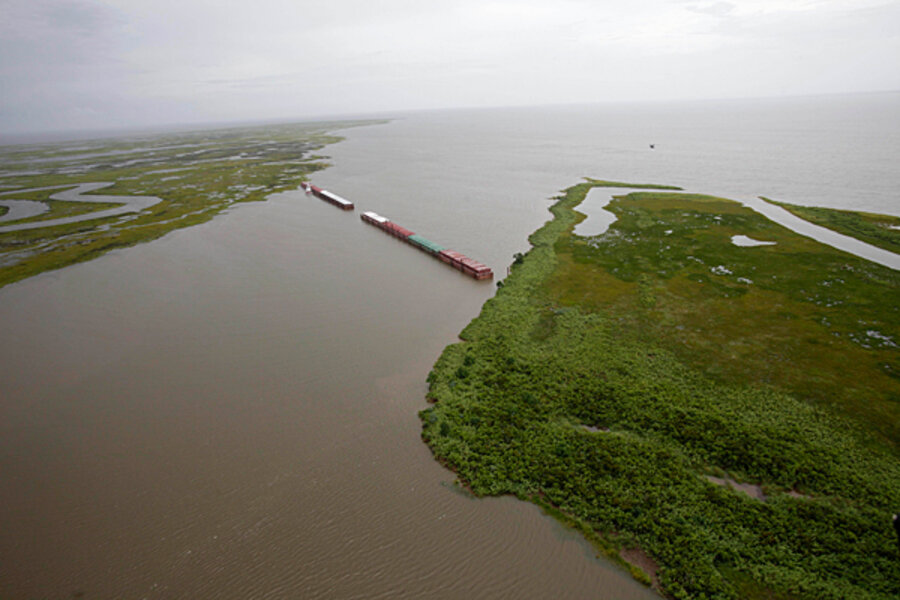Lake Pontchartrain in New Orleans now has tar balls, oily sheen
Loading...
| New Orleans
New Orleans, which managed to escape the oil from the BP spill for more than two months, can't hide any longer.
For the first time since the accident, oil from the ruptured well is seeping into Lake Pontchartrain, threatening another environmental disaster for the huge body of water that was rescued from pollution in 1990s to become, once more, a bountiful fishing ground and a popular spot for boating and swimming.
"Our universe is getting very small," Pete Gerica, president of the Lake Pontchartrain Fishermen's Association, said Tuesday.
IN PICTURES: The Gulf oil spill's impact on nature
Over the July Fourth weekend, tar balls and an oil sheen pushed by strong winds from faraway Hurricane Alex slipped past lines of barges that were supposed to block the passes connecting the Gulf of Mexico to the lake.
State authorities closed the lake's eastern reaches to fishing on Monday, though most of it remained open. Barges were lined up at bayous and passes to stop the oil from coming in, and cleanup crews Tuesday used nets to collect tar balls from marinas and docks. They also planned to lay out 9,000 feet (2,700 meters)of special permeable booms. But the lake was too choppy for skimmer vessels to operate.
About 1,700 pounds (770 kilograms) of oily waste has been collected, said Suzanne Parsons Stymiest, a spokeswoman for St. Tammany Parish.
The amount of oil infiltrating 600-square-mile (1,554-square-kilometer) Lake Pontchartrain appears small so far. And tests on seafood have not turned up any oil contamination, said Brian Lezina, a state biologist. But the pollution is distressing to the many people in Louisiana who have a deep attachment to the lake.
"You won't hear songs about a lot of the marshes in south Louisiana, but you will hear songs about Lake Pontchartrain," Lezina said.
Out in the Gulf, meanwhile, stormy weather kept skimmers from working offshore Tuesday for yet another day and delayed the hookup of a big new ship intended to suck more crude from the gushing well. Also, the arrival of a Navy blimp intended to hover above the relief effort was delayed until Friday.
Tar balls from the spill also washed up on Texas beaches over the holiday weekend, meaning the disaster now touches all five Gulf Coast states, spanning more than 500 miles (804 kilometers) of coastline.
Lake Pontchartrain, named for the French count of Pontchartrain during the reign of Louis XIV, is on the northern edge of the city. It is connected to the Gulf of Mexico by two main passes: the Rigolets, a winding passage of about 10 miles (16 kilometers), and the Chef Menteur, around nine miles (14 kilometers) long.
For centuries, it has been a playground, a source of seafood and a backdoor route to New Orleans for invading British troops and hurricane storm surge.
Until the 1970s, its shores were a top destination for city folks who took streetcars and buses to the lake to swim and to dine at restaurants that cooked up the lake's crabs and other seafood. They played in penny arcades and rode the Zephyr roller coaster at the Pontchartrain Beach amusement park.
But pollution shut down the swimming and chased away marine life, and the amusement park closed in the early 1980s.
The lake's restoration included a ban on commercial clam dredging and new regulations governing urban runoff. Slowly, the lake revived. In recent years, sightings of dolphins and manatees have delighted locals, and commercial and recreational fishing is thriving.
About 60 commercial fishermen catch blue crabs and shrimp in the lake, and scores of sport fishermen can be found on any given day reeling in speckled trout, redfish, flounder, black drum and sheepshead.
IN PICTURES: The Gulf oil spill's impact on nature
Related





